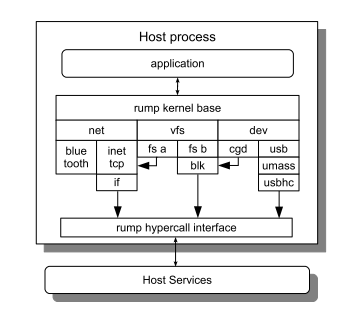Rump kernel

The NetBSD rump kernel is the first implementation of the "anykernel" concept where drivers either can be compiled into and/or run in the monolithic kernel or in user space on top of a light-weight rump kernel.[1][2][3][4] The NetBSD drivers can be used on top of the rump kernel on a wide range of POSIX operating systems, such as the Hurd,[5] Linux, NetBSD, DragonFlyBSD, Solaris and even Cygwin, along with the file system utilities[6] built with the rump libraries. The rump kernels can also run without POSIX directly on top of the Xen hypervisor, the L4 microkernel in Genode OS or even on "OS-less" bare metal.
Anykernel
An anykernel is different in concept from microkernels, exokernels, partitioned kernels or hybrid kernels in that it tries to preserve the advantages of a monolithic kernel, while still enabling the faster driver development and added security in user space.[7] The "anykernel" concept refers to an architecture-agnostic approach to drivers where drivers can either be compiled into the monolithic kernel or be run as a userspace process, microkernel-style, without code changes.[8] With drivers, a wider concept is considered where not only device drivers are included but also file systems and the networking stack.
File System Access Utilities
The File System Access Utilities (fs-utils) is a subproject built with the rump libraries. It aims to have a set of utilities to access and modify a file system image without having to mount it. The fs-utils does not require superuser account to access to the image or device. The advantage of fs-utils over similar projects such as mtools is supporting the usage of familiar with filesystem Unix commands (ls, cp, mv, cd, etc.) for a large number of file systems which are supported by NetBSD.[9]
See also
References
- ↑ "The Anykernel and Rump Kernels". Netbsd.org. Retrieved 2013-08-15.
- ↑ "FOSDEM 2013 - Interview: Antti Kantee:The Anykernel and Rump Kernels". archive.fosdem.org. 2013-02-03. Retrieved 2013-08-15.
- ↑ "FOSDEM 2013 - The Anykernel and Rump Kernels". archive.fosdem.org. 2013-02-03. Retrieved 2013-08-15.
- ↑ "FOSDEM 2014 - Rump Kernels, Just Components". archive.fosdem.org. 2014-02-03. Retrieved 2015-02-21.
- ↑ "Hurd, Rump kernel, sound, and USB". FOSDEM 2016. Retrieved February 15, 2016.
- ↑ file system utilities
- ↑ Kantee, Antti (2012). The Design and Implementation of the Anykernel and Rump Kernels (Ph.D). Aalto university.
- ↑ "Rump File Systems: Kernel Code Reborn". Usenix.org. 2002-02-01. Retrieved 2013-08-15.
- ↑ Kantee, Antti; Ysmal, Arnaud (2009). Fs-utils: File Systems Access Tools for Userland (PDF) (Thesis).